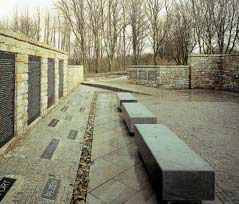Little Camp Memorial Dedicated at Buchenwald
 Fifty-seven years after the liberation of Buchenwald concentration camp in Germany, Warren L. Miller, JD ’69, has helped ensure that the world never forgets the unimaginable atrocities that occurred there. Fifty-seven years after the liberation of Buchenwald concentration camp in Germany, Warren L. Miller, JD ’69, has helped ensure that the world never forgets the unimaginable atrocities that occurred there.
Thanks to Miller’s tenacity, April 14 marked the official dedication of a memorial at the infamous “Little Camp” at Buchenwald—the site of tremendous suffering and thousands of deaths that was memorialized by survivor and Nobel Prize winner Elie Wiesel in his book, Night. “The “Little Camp,” where inmates were subjected to the most barbaric conditions, had been totally neglected for nearly 50 years and was overgrown with trees and brush,” says Miller, a prominent Washington trial attorney and presidentially-appointed chairman of the U.S. Commission for the Preservation of America’s Heritage Abroad.
Miller proposed a Little Camp memorial in 1995, when he spoke at ceremonies at Buchenwald commemorating the 50th anniversary of the camp’s liberation. He persuaded German authorities to allow the creation of the memorial, raised the necessary funds, coordinated the implementation, and wrote the powerful wall text, which appears in six languages. “The memorial could easily have been just a stone edifice or some symbolic structure, but I insisted there be a narrative on the walls that accurately describes the horrors that took place at the site—something that would strongly impact future visitors,” says Miller. Buchenwald is the most visited of all of the camps, receiving approximately 700,000 visitors annually.

Warren Miller’s seven-year odyssey to build a memorial for the victims at Buchenwald’s forgotten “Little Camp” finally came to an end on April 14, 2002. Separated by only a barbed-wire fence from the main camp, the Little Camp was notorious for its brutal and barbaric conditions. Miller raised funds from private donors to ensure that the camp’s atrocities will never be forgotten.
|
Miller solicited the help of New York architect and Buchenwald survivor Stephen B. Jacobs, who was liberated from the camp at age 5, to serve as the memorial’s architect. A roofless, stone structure, the memorial features a cobblestone floor evoking memories of Eastern and Central European streets, a gnarled tree trunk, symbolizing the continuity of life, and triangular designs, recalling the triangular badges worn by the inmates. The names of cities, ghettos, and other camps that prisoners came from are etched on the floor.
More than 1,000 people, including survivors from 24 countries, attended opening ceremonies for the memorial at Buchenwald on April 14. Miller’s efforts were also recognized at a March 13 ceremony at the U.S Holocaust Memorial Museum in Washington, attended by some 400 ambassadors, congressmen, senior presidential aides, survivors, and liberators of the camp.
–Jamie L. Freedman
Back to top | Fall 2002 Table of Contents
|